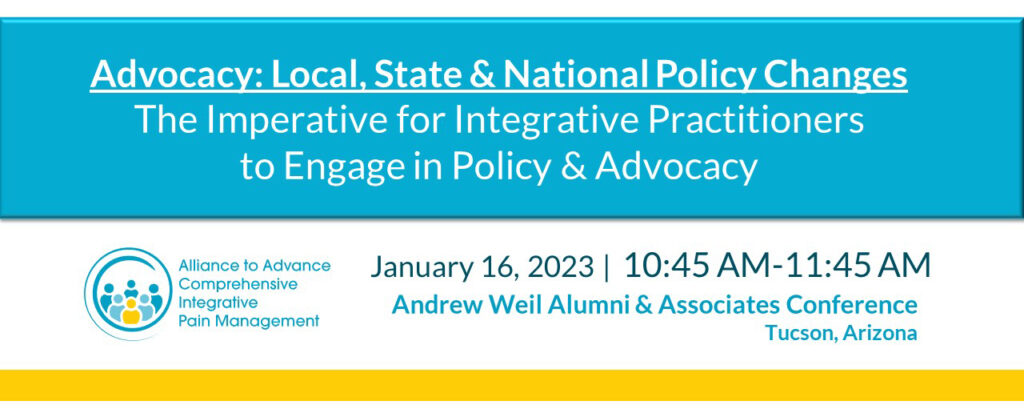Conference
We are honored to collaborate with Andrew Weil Fellowship program to present to their fellowship alumni about engaging in policy and advocacy. You can view more information about this meeting and agenda here.

Session Background:
This session will provide practitioners an understanding of the current coverage landscape, policy gaps that must be addressed if care delivery is to improve, and the ethical obligation that healthcare providers have to participate in the formation of healthcare policy. Practitioners will learn about the types of policies and policymakers that affect access to integrative care, the moral and ethical imperative for health care providers to participate in the creation of health care policy, and options for engaging in advocacy efforts related to expanding access to guideline-concordant integrative care.
References and Resources
Background, Alliance to Advance Comprehensive Integrative Pain Mgmt
- AACIPM home page
- Link to Andrew Weil presentation from 1/16/23
- Why we need AACIPM
- The CIPM Toolbox
- Relevance of pain policy
Why is Advocacy important
- Ethical position statement example (CMSS) Council of Medical Specialty Societies
- National Pain Advocacy Center
- Physician Advocacy: What is it and how do we do it
- Misperceptions & Stigma
- People with pain often face both hidden and obvious stigma from family, friends, coworkers, and the health care system.
- Racial and ethnic stereotyping by physicians can affect the way pain is assessed and managed. Pain assessment is subjective, and the way it’s assessed can interfere with how it is treated.
- Pain can affect anyone
- Racial bias in pain assessment and treatment recommendations, and false beliefs about biological differences between blacks and whites
- Intersection of pain, SUD and mental health
- Lack of Education and Awareness
- National Pain Strategy Comprehensive Population Health-Level Strategy for Pain.
- Reference Robert Bonakdar, MD slides from a panel presentation at Academic Consortium of Integrative Medicine
- HHS Pain Management Best Practices Task Force Report, 2019
- Becker WC, Dorflinger L, Edmond SN, Islam L, Heapy AA, Fraenkel L. Barriers and facilitators to use of non-pharmacological treatments in chronic pain. BMC Family Practice. 2017;18(1). doi:10.1186/s12875-017-0608-2
- Gadde U, Matthew P, Kumar R, Aggarwal R, Piazza MD, Lamba S. Implementing an Interactive Introduction to Complementary Medicine for Chronic Pain Management Into the Medical School Curriculum. MedEdPORTAL. 2020 Dec 29;16:11056. doi: 10.15766/mep_2374-8265.11056. PMID: 33409356; PMCID: PMC7780745
- Business Case Data Disagreement
- Workforce Supply & Demand
- In addition to an overall provider shortage that is only worsening, there is an extreme shortage of an array of licensed healthcare providers that effectively represent BIPOC communities. Further, there is inadequate training and interprofessional knowledge that keeps healthcare providers from understanding what it means to provide a multimodal, multidisciplinary approach to pain care.
- HRSA estimates for supply and demand
- HRSA U.S. health care workforce data tools
- Optum Healthcare Provider Data
- Misaligned Financial Incentives
Excellent examples from a growing many
Some stories about:
- FQHC in Texas doing integrative care through innovation and collaboration (AMA did a story here)
- Interventional turned Integrative Pain Program in West Virginia (AMA did a story here)
- Neurosurgeon and multimodal care, with emphasis on yoga (AMA did a story here)
- Bundled payment for Comprehensive Pain Program with BC/BS of VT and UVMC
- ECHO program in New Mexico
- Madigan multidisciplinary program
- Duke’s report about 4 of the above programs as examples
- Integration & Cultural Incompatibilities
- Integration of conventional clinical care and complementary and integrative health is complicated.
- State pain policy examples
- Colorado example and actuarial report from AMA linked
- Whole Health in the States
- Policy Levers to Develop Value-Based Payment Models for FQHCs – The National Academy for State Health Policy
- BC/BS partnership with UVMC, Comprehensive Pain Program
- Integration & Cultural Incompatibilities
Integration and Cultural Incompatibilities
Whole Systems Within Whole Systems: The Oregon Health Plan’s Expansion of Services for Back and Neck Pain
Low Back Pain Examples
- The Global Burden of Low Back Pain – International Association for the Study of Pain (IASP)
- Chronic Back Pain | Health Policy Institute | Georgetown University
Acupuncture Examples
- Trends in Insurance Coverage for Acupuncture, 2010-2019 | Complementary and Alternative Medicine | JAMA Network Open | JAMA Network
- Acupuncture in the emergency department for pain management: A BraveNet multi-center feasibility study – PubMed
- DVHA Acupuncture Pilot Outcomes Report (PDF)
- NCD – Acupuncture for Chronic Lower Back Pain (cLBP) (30.3.3)
- Example, Medicaid determination for acupuncture in Massachusetts, 2020
- The Hospital Handbook Project™
Other Examples
-
- Levels of Patient Access to Physical Therapist Services in the U.S.
- Beyond Professional Licensure: A Statement of Principle on Culturally-Responsive Healthcare – Nadine Ijaz, Michelle Steinberg, Tami Flaherty, Tania Neubauer, Ariana Thompson-Lastad, 2021
- LHCP Yoga Therapy Today Fall 2017 (PDF)
- The North American yoga therapy workforce survey
- Massage Therapy in Integrative Care & Pain Management | AMTA
- Guidelines, National Efforts
- Federal Efforts
- Legislative Engagement
- Regulatory Engagement
- A Guide to the Rulemaking Process (HHS)
National Academies of Medicine
Blog about Whole Health and Comprehensive Addiction and Recovery Act (CARA)
IOM 2011 Report, Relieving Pain in America
NAM Opioid Action Collaborative
NAM NonPharm Workshop Proceedings 2019 (PDF)
Resources at the VA/DOD
- Advanced by passage of CARA, Veterans connected to Whole Health increased by 193%
- Connecting the Dots: NAM, CARA and Whole Health
- Spotlight on VA’s Pilot Site in St. Louis – Dr. Kavitha Reddy
- CMS Approves New HCPCS Codes for Spiritual Health (VA)
- Improving Transition from Military Service Member to Veteran through Quality Comprehensive Well-Being Experiences
